Category: Other Documents

IRS – APA Study Guide issued in early 2000s
In the early 2000s the IRS issued a “APA study guide” where guidance is provided in relation to various practical issues in the area of transfer pricing. The study guide is part of a large collection of IRS practices and statistics from working with MAP and APA that can be accessed via this link.
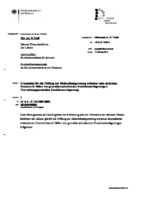
German Guidance on Business Restructuring and Valuation issued in October 2010
In 2008 German legislation on business restructurings was updated to align with the new chapter XI in the OECD Transfer Pricing Guidelines. § 1 para. 3 AStG and the “Regulation on the application of the arm’s length principle according to §1 para. 1 AStG in cases of cross-border relocation of functions” of 12.8.2008 (Function Relocation Regulation, in short: FVerlV). Guidance was subsequently issued by the tax authorities in BMF letter of 13 October 2010, IV B 5 – S 1341/08/10003, BStBl 2010 I p. 774; in short: VWGFVerl. Click here for unofficial English translation Click here for other translation
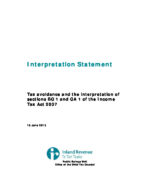
Statement released by New Zealand’s Inland Revenue on determining whether an Arrangement is Tax Avoidance
On 13 June 2013, a Statement was released by New Zealand’s Inland Revenue Service on the interpretation of Tax Avoidance provisions. This statement outlines the Commissioner’s view of the law on tax avoidance in New Zealand and sets out the approach the Commissioner will take to application of the general anti-avoidance provision, based on the three-stage test for assessing whether an arrangement is tax avoidance as provided by the Supreme Court Judgment in the Ben Nevis case. In Ben Nevis case the Supreme Court indicated it intended to settle the approach regarding the relationship between s BG 1 and the rest of the Income Tax Act. This has been acknowledged in all relevant judicial decisions released since Ben Nevis. Accordingly, the Commissioner considers that the statement is based upon and reflects the view of the court in Ben Nevis.
Belgium,March 2016: New list of “tax havens” published for 2016
According to a royal decrete dividends received deduction is not available in Belgium where the recieving company is resident in a country defined to be a “tax haven” A tax haven is defined as a country where: (1) the nominal rate of the corporate income tax is less than 15%; or (2) the effective corporate tax burden is less than 15%. The Belgien list of “tax haven” jurisdictions for 2016 contains the following countries: Abu Dhabi, Ajman, Andorra, Bosnia and Herzegovina, Dubai, Gibraltar, Guernsey, Jersey, Kyrgyzstan, Kuwait, Kosovo, Liechtenstein, Macao, Macedonia, Maldives, Isle of Man, Marshall Islands, Micronesia, Moldova, Monaco, Montenegro, Oman, Uzbekistan, Paraguay, Qatar, Ras al Khaimah, Serbia, Sharjah, East Timor, Turkmenistan, and Umm al Quaiwain.

TAX BATTLES – The dangerous global Race to the Bottom on Corporate Tax
This report from www.oxfam.org examines tax competition, and the resultant race to the bottom in the taxation of global corporations. Using new research, this report exposes the world’s corporate tax havens – the 15 countries which facilitate the most extreme forms of tax dodging. The report looks at the harm caused by falling corporate tax rates and tax giveaways in countries across the world. Finally, the report identifies clear actions governments can take to act in the interest of their citizens and put an end to tax havens and the race to the bottom. bp-race-to-bottom-corporate-tax-121216-en.pdf
Oxfam’s list of Tax Havens, December 2016
Oxfam’s list of Tax Havens, in order of significance are: (1) Bermuda (2) the Cayman Islands (3) the Netherlands (4) Switzerland (5) Singapore (6) Ireland (7) Luxembourg (8) Curaçao (9) Hong Kong (10) Cyprus (11) Bahamas (12) Jersey (13) Barbados, (14) Mauritius and (15) the British Virgin Islands. Most notably is The Netherlands placement as no. 3 on the list. Oxfam researchers compiled the list by assessing the extent to which countries employ the most damaging tax policies, such as zero corporate tax rates, the provision of unfair and unproductive tax incentives, and a lack of cooperation with international processes against tax avoidance (including measures to increase financial transparency). Many of the countries on the list have been implicated in tax scandals. For example Ireland hit the headlines over a tax deal with Apple that enabled the global tech giant to pay a 0.005 percent corporate tax rate in the country. And the British Virgin Islands is home to more than half of the 200,000 offshore companies set up by Mossack Fonseca – the law firm at the heart of the Panama Papers scandal. The United Kingdom does not feature on the list, but four territories that the United Kingdom is ultimately responsible for do appear: the Cayman Islands, Jersey, Bermuda and the British Virgin Islands.
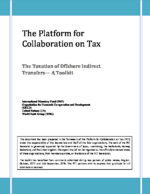
A Toolkit on the Taxation of Offshore Indirect Transfers
The Platform for Collaboration on Tax (IMF, OECD, UN and the WBG) has published a toolkit on the taxation of Offshore Indirect Transfers. The tax treatment of ‘offshore indirect transfers’ (OITs) – in essence, the sale of an entity owning an asset located in one country by a resident of another – has emerged as a significant issue in many developing countries. It has been identified in IMF technical assistance work and scoping by the OECD, but was not covered by the G20-OECD project on Base Erosion and Profit Shifting (BEPS). In relation to the extractive industries, OITs are also the subject of work at the UN. The country in which the underlying asset is located may wish to tax gains realized on such transfers – as is currently the case for direct transfers of immovable assets. Such treatment might reasonably be applied to a wider class of assets, to include more those generating location specific rents—returns that exceed the minimum required by investors and which are not available in other jurisdictions. This might include, for instance, telecom licenses and other rights issued by government. The report also recognizes, however, that gains on OITs may be attributable in part to value added by the owners and managers of such assets, and that some countries may choose not to tax gains on OITs. The provisions of both the OECD and the UN Model treaties suggest wide acceptance that capital gains taxation of OITs of “immovable” assets can be imposed by the location country. It remains the case, however, that the relevant model Article 13(4) is found only in around 35 percent of all Double Tax Treaties (DTTs), and is less likely to be found when one party is a low income resource rich country. To date, the Multilateral Convention has increased the number of tax treaties that effectively include Article 13(4) of the OECD MTC. This impact is expected to increase as new parties sign the MC and amend their covered tax treaties to include the new language of Article 13(4). Whatever treaties may or may not come into play, however, such a taxing right cannot be supported without appropriate definition in domestic law of the assets intended to be taxed and without a domestic law basis to assert that taxing right. There is a need for a more uniform approach to the taxation of OITs by those countries that choose to tax them. Countries’ unilateral responses have differed widely, in terms of both which assets are covered and the legal approach taken. Greater coherence could enhance tax certainty. The report outlines two main approaches to the taxation of OITs by the country in which the underlying asset is located – provisions for which require careful drafting. It identifies the two main approaches for so doing and provides, for both, sample simplified legislative language for domestic law in the location country. One of these methods (‘Model 1’) treats an OIT as a deemed disposal of the underlying asset. The other (‘Model 2’) treats the transfer as being made by the actual seller, offshore, but sources the gain on that transfer within the location country and so enables that country to tax it. The report expresses no general preference between these: the appropriate choice will depend on countries’ circumstances and preferences. In the toolkit reference is made to the following caselaws India—The Vodafone Case Peru—The Acquisition of Petrotech Uganda—The Zain Case
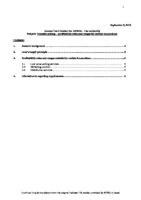
Israel – Guidance on Limited Risk Distribution – Circular 11/2018
Circular on transfer pricing – profitability rates and ranges for certain transactions – Limited Risk Distributors (LRDs)

German royalty barrier to counter IP box-regimes
Some countries in Europe offer so-called IP or Patent boxes. To counter such tax practices, effective from 31 December 2017, Germany has introduced a new royalty barrier in ‘Law against Harmful Tax Practices in Connection with the Assignment of Rights. The law limits tax deductibility of expenses for the assignment of rights in order to prevent royalty income from not being taxed or taxed at a low rate and taxes income in the country where value is/was created. Deduction of expenses for the assignment of rights is restricted, where the following two cumulative requirements are met: 1) Royalty income for the assignment of rights is subject to low taxation which differs from standard taxation in the recipient’s country (preferential regime) 2) The licensor is a related party to the licensee within the meaning of Section 1 Paragraph 2 German Foreign Tax Act. Under these circumstances, expenses are not (or only partially) tax deductible. The non-deductible part of these expenses is calculated as: (25% – income tax burden in %) / 25%. The royalty barrier does not apply if low taxation is the result of a preferential regime of the licensor’s income that follows the Nexus Approach according to Chapter 4 of the OECD’s Action 5 final report.

Israel – Guidance on Limited Risk Distribution – Circular 12/2018
Circular on transfer pricing – profitability rates and ranges for certain transactions – Limited Risk Distributors (LRDs)
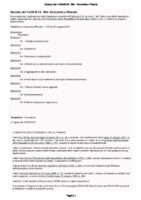
Italien Transfer Pricing Guidelines, Ministerial Decree of 14 May 2018, published in the Official Gazette no. 118/2018
Italien legislation on transfer pricing is contained in Article 110, paragraph 7 of the Consolidated Income Tax Act, where the first sentence states that “the components of income deriving from transactions with companies not resident in the territory of the State, which directly or indirectly control the company, are controlled by it or are controlled by the same company that controls the company, are determined by reference to the terms and prices that would have been agreed between independent parties operating in conditions of free competition and in comparable circumstances, if an increase in income is the result”. The rule was last amended by Article 59 of Decree-Law No. 50/2017 which, as far as it is of interest, replaced the reference to “normal value” with the “arm’s length principle”, referred to in the aforementioned Article 9 of the OECD Model Convention, in determining the value of transactions between associated enterprises operating in different States. At the level of secondary legislation, the Ministerial Decree of 14 May 2018, published in the Official Gazette no. 118/2018, contains the guidelines for the application of the provisions contained in paragraph 7 of Article 110 on transfer pricing. Click here for unofficial English translation

UK – Profit Diversion Compliance Facility (PDCF) Published by HMRC January 2019
HMRC Profit Diversion Compliance Facility Chapter 1 – introduction 1.1 Background Companies should recognise and pay tax on profits where the economic activities to generate those profits are carried out. HMRC has found that some Multinational Enterprises (MNEs) have adopted cross border pricing arrangements which are based on an incorrect fact pattern and/or are not consistent with the Organisation for Economic Co-operation and Development (OECD) Transfer Pricing Guidelines (TPG), as clarified through Actions Points 8-10 of the OECD Base Erosion and Profit Shifting Project. This is for 2 main reasons: Firstly, some have made incorrect assumptions, or not implemented arrangements as originally intended or declared to HMRC, so that there is a divergence between the fact pattern on which the Transfer Pricing (TP) analysis is based, and what is actually happening on the ground. This could be for a variety of reasons, including: insufficient understanding or incorrect/misleading statements on the nature or relative value of functions, assets and risks at the outset businesses change over time so that the functional profile may become different from that originally assumed or intended some businesses undervalue the contributions made by staff in the UK and overvalue the contributions of staff in other tax jurisdictions Secondly, the TP policies are not in accordance with the OECD TPG, for example because of: over reliance on TP policies predicated on contractual assumption of risk and legal ownership of assets, giving insufficient weight to the location of the control functions and/or the contributions to those control functions in relation to the risk and/or the important functions in relation to the assets too heavy a reliance on inappropriate comparables These arrangements often result in a reduction of UK profits, and may involve the diversion of UK profits to an overseas entity where the profits are taxed at lower rates or not at all. In a high proportion of investigations into such arrangements HMRC is finding that the arrangements don’t stand up to scrutiny and significant additional tax is due. The Diverted Profits Tax (DPT) was introduced to encourage MNEs using such arrangements to change their behaviour and pay Corporation Tax on profits in line with economic activity. Many MNEs with arrangements targeted by DPT have changed their TP policy and/or business structure leading to the right amount of UK Corporation Tax being paid, eliminating any potential DPT. 1.2 Co-operative Compliance HMRC prefers MNEs to fully disclose significant tax uncertainties or inaccuracies and to ensure compliance with tax law, and will work co-operatively, proactively and transparently with MNEs to resolve any tax uncertainties and risks. 1.3 Profit Diversion Compliance Facility HMRC is introducing a new Profit Diversion Compliance Facility for MNEs using arrangements targeted by DPT to give them the opportunity to bring their UK tax affairs up to date. HMRC recognises that many MNEs operate TP policies to achieve compliance with the OECD TPG, regularly review and update their policies, and discuss them with HMRC during business risk reviews and at other times. If a MNE is confident that their transfer pricing is up to date and they are paying the right amount of Corporation Tax, then they should not use the new compliance facility. The new facility is designed to encourage MNEs with arrangements that might fall within its scope to review both the design and implementation of their TP policies, change them if appropriate, and use the facility to put forward a report with proposals to pay any additional tax, interest and where applicable, penalties due. This will: enable MNEs to bring their tax affairs up to date openly, efficiently and without investigation by HMRC if a full and accurate disclosure is made give them certainty for the past and a low risk outcome for profit diversion in the future provide an accelerated process, HMRC will aim to respond to the proposal within 3 months of submission allow the MNE to manage its own internal processes around what evidence to gather, who is interviewed, what comparables are used (if any), and how the analysis is presented give unprompted penalty treatment if HMRC has not already started an investigation into profit diversion, 31 December 2019 is an important deadline for registration for some MNEs (see section 3 of chapter 4 of this guidance) This guidance sets out what HMRC would expect to see in such a report. The review of the arrangements should be proportionate to the scale and complexity of the business, the extent of tax at risk, the cause of any inaccuracies and failures to notify, and the proposals. The report should be free standing and self-explanatory. While it will be the responsibility of the MNE to review its arrangements and make a disclosure, HMRC is prepared to meet with MNEs who register to use the facility at the outset of the process to discuss plans for the review and later again before the final report and proposal is submitted, so that the MNE can present its findings and conclusions and hear any comments from HMRC. This work will be a priority for HMRC and a specifically designated, experienced team of specialists will risk assess all reports when received and consider whether the facts described and conclusions reached are soundly based on appropriate evidence, and if the TP policy and methodology adopted is reasonable and consistent with the OECD TPG. HMRC expects to be able to accept most proposals if they take account of this guidance and reflect the principles in it. Even if HMRC cannot accept the proposals as first presented, the report should provide a good basis for quick and efficient resolution, through dialogue, of particular differences of view between HMRC and the MNE. While the facility is aimed at arrangements targeted by DPT, businesses do not need to provide a technical analysis of whether DPT applies if they consider that their proposals eliminate any profit potentially chargeable to DPT. All technical analysis and any payment made can be on a without prejudice basis. HMRC will not regard the making of a proposal as indicating that the MNE thinks DPT could, or should, apply. 1.4 HMRC investigations Tackling profit diversion is a priority for HMRC. HMRC is conducting extensive research and data analysis and has invested in new teams of investigators. Investigations into profit diversion are usually resolved by agreeing transfer pricing adjustments. HMRC has identified a number of MNEs in a variety of business sectors which could be diverting profits,
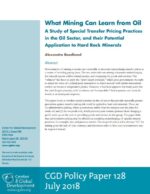
July 2018: Transfer Pricing Practices in the Oil Sector, and their Potential Application to Mining
In July 2018 Center for Global Development published a study of special transfer pricing practices in the oil sector, and their potential application to hard rock minerals. According to the study, governments of mining countries are vulnerable to investors manipulating transfer prices as a means of avoiding paying taxes. The two main risks are mining companies undercharging for mineral exports sold to related parties, and overpaying for goods and services. The “solution” has been to apply the “arm’s length principle,” which gives governments the right to adjust the value of a related party transaction so that it accords with similar transactions carried out between independent parties. However, it has been apparent for many years that the arm’s length principle, with its reliance on “comparables” that in practice can rarely be found, is an inadequate response. The paper looks at whether special practices in the oil sector that provide materially greater protection against transfer pricing risk could be applied to hard rock minerals. These are (1) administrative pricing, where government, rather than the taxpayer sets the price for crude oil; and (2) the no-profit rule, which prevents joint venture partners from charging a profit mark-up on the cost of providing goods and services to the group. The paper finds that administrative pricing may be effective at curtailing undercharging of specific mineral products, for example, base and precious metals. The no-profit rule is a less obvious “fit” for mining given the lack of joint ventures, and alternative rules to limit cost overstatement may be required instead.
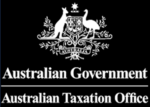
March 2019: ATO – Risk assessment of inbound distribution arrangements
The Guideline outlines ATO’s compliance approach to the transfer pricing outcomes associated with the following activities of inbound distributors: distributing goods purchased from related foreign entities for resale, and distributing digital products or services where the intellectual property in those products or services is owned by related foreign entities Such activities, together with any related activities involving the provision of ancillary services, are referred to in this Guideline as ‘inbound distribution arrangements’. This Guideline applies to inbound distribution arrangements of any scale. The framework in the Guideline is used to assess the transfer pricing risk of inbound distribution arrangements and tailor our engagement with you. Where this Guideline applies, we rate the transfer pricing risk of your inbound distribution arrangements having regard to a combination of quantitative and qualitative factors. If an inbound distribution arrangements fall outside the low transfer pricing risk category, the transfer pricing outcomes of the arrangements can be expected to be monitor, tested and/or verified. The framework set out in the Guideline can be used to: assess the transfer pricing risk of inbound distribution arrangements understand the compliance approach given the transfer pricing risk profile of the inbound distribution arrangements mitigate the transfer pricing risk of the inbound distribution arrangements Structure of the Guideline The Guideline is structured as follows: the main body sets out general principles relevant to our framework for assessing transfer pricing risk and applying compliance resources to inbound distribution arrangements to which the Guideline applies, and the schedules set out quantitative and qualitative indicators relevant to distributors generally or based on their industry sector, including those that operate in the life science, information and communication technology (ICT) and motor vehicle industries. This Guideline does not provide advice or guidance on the technical interpretation or application of Australia’s transfer pricing rules or other tax provisions.

2018: ATO Taxpayer Alert on Mischaracterisation of activities or payments in connection with intangible assets (TA 2018/2)
The ATO is currently reviewing international arrangements that mischaracterise intangible assets[1] and/or activities or conditions connected with intangible assets. The concerns include whether intangible assets have been appropriately recognised for Australian tax purposes and whether Australian royalty withholding tax obligations have been met. Arrangements that allocate all consideration to tangible goods and/or services, arrangements that allocate no consideration to intangible assets, and arrangements that view intangible assets collectively, or conceal intangible assets, may be more likely to result in a mischaracterisation. Where arrangements are between related parties, we are concerned about whether the: amount deducted by the Australian entity under the arrangement meets the arm’s length requirements of the transfer pricing provisions in the taxation law[2] functions performed, assets used and risked assumed by the Australian entity, in connection with the arrangement, are appropriately compensated in accordance with the arm’s length requirements of the transfer pricing provisions in the taxation law. These arrangements typically display most, if not all, of the following features: intangible assets are developed, maintained, protected or owned by an entity located in a foreign jurisdiction (an ‘IP entity’) the Australian entity enters into an arrangement to undertake an activity or a combination of activities the Australian entity requires the use of the relevant intangible assets in order to undertake these activities the Australian entity purchases goods and/or services from an IP entity or a foreign associate of an IP entity in order to undertake these activities the Australian entity agrees to pay an amount, or a series of amounts, to a foreign entity which the Australian entity does not recognise or treat as wholly or partly being for the use of an IP entity’s intangible assets. This Taxpayer Alert (Alert) does not apply to international arrangements which involve an incidental use of an intangible asset. For example, this Alert does not apply to resellers of finished tangible goods where the activity of reselling the goods involves an incidental use of a brand name that appears on the goods and related packaging. Whether a use is incidental in this sense will depend on an analysis of the true relationship and activities of the parties. The fact that an arrangement fails to expressly provide for the use of an intangible asset does not, in itself, determine that a use is incidental.

2019: ATO draft on compliance approach to the arm’s length debt test
The draft Guideline provides guidance to entities in applying the arm’s length debt test in Division 820 of the Income Tax Assessment Act 19972 and should be read in conjunction with draft Taxation Ruling TR 2019/D2 Income tax: thin capitalisation – the arm’s length debt test. This Guideline also provides a risk assessment framework that outlines our compliance approach to an application of the arm’s length debt test in certain circumstances that are identified as low risk. The arm’s length debt test is one of the tests available to establish an entity’s maximum allowable debt for thin capitalisation purposes. The test focuses on identifying an amount of debt a notional stand-alone Australian business would reasonably be expected to borrow, and what independent commercial lenders would reasonably be expected to lend on arm’s length terms and conditions. An entity’s debt deductions are reduced to the extent that its adjusted average debt exceeds its maximum allowable debt. The arm’s length debt test may be used to support debt deductions for commercially justifiable levels of debt. In practice, the test is typically only used when an entity is unable to satisfy the safe harbour and worldwide gearing tests (as the compliance burden of applying these tests is generally lower). It is not common for Australian businesses to gear in excess of 60% of their net assets and historically relatively few entities have applied the arm’s length debt test. We consider the choice to apply the arm’s length debt test carries with it the necessity to undertake more rigorous analysis than the safe harbour and worldwide gearing tests. While the arm’s length debt test in some respects draws upon arm’s length concepts that are broadly common to transfer pricing, the test itself is not a transfer pricing analysis, nor does it necessarily proxy an outcome consistent with the arm’s length conditions under Subdivision 815-B. Rather it requires an overlay of factual assumptions that produce a hypothetical entity against which specific factors are to be assessed. This Guideline is limited to providing guidance and a risk assessment framework relating to the application of the arm’s length debt test contained in sections 820-105 and 820-215. It does not set out our approach to reviewing other taxation issues that might arise in relation to debt deductions.

2020: ATO Alert on arrangements and schemes connected with DEMPE of intangibles
The ATO is currently reviewing international arrangements that mischaracterise Australian activities connected with the development, enhancement, maintenance, protection and exploitation (DEMPE) of intangible assets. Such arrangements may be non-arm’s length or structured to avoid tax obligations, resulting in inappropriate outcomes for Australian tax purposes. One of the issues is whether functions performed, assets used and risks assumed by Australian entities in connection with the DEMPE of intangible assets are properly recognised and remunerated in accordance with the arm’s length requirements of the transfer pricing provisions in the taxation law. These arrangements are particularly in focus where intangible assets and/or associated rights are migrated to international related parties as part of non-arm’s length arrangements and/or in a manner intended to avoid Australian tax. In circumstances where these arrangements lack evidence of commercial rationale and/or substance, the ATO will apply of the exceptions in the transfer pricing provisions (non-recognition) and anti-avoidance rules. The general anti-avoidance rule (GAAR) or diverted profits tax (DPT) provisions may apply where a tax benefit or DPT tax benefit is obtained in connection with these arrangements. Arrangements of particular concern include, but are not limited to, those described in the Alert.
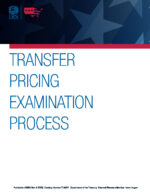
September 2020: IRS Guide to the Transfer Pricing Examination Process
September 8, 2020 the IRS released a new guide to Transfer Pricing Examination Process. The Transfer Pricing Examination Process (TPEP) provides a guide to best practices and processes to assist with the planning, execution, and resolution of transfer pricing examinations consistent with the Large Business & International (LB&I) Examination Process (LEP), Publication 5125. This guide will be shared with taxpayers at the start of a transfer pricing examination, so they understand the process and can work effectively with the examination team. Transfer pricing examinations are factually intensive and require a thorough analysis of functions performed, assets employed, and risks assumed along with an accurate understanding of relevant financial information. They are resource intensive for both the IRS and taxpayers. To ensure resources are applied effectively, LB&I is using data analytics to identify issues for examination that have the most significant risk for non-compliance. In addition, teams should continually assess the merits of issues during an examination. Our goal in a transfer pricing examination is to determine an arm’s length result under the facts and circumstances of the case. Teams should keep an open mind during an examination to new facts as they are identified. Arm’s length results are rarely a precise answer, but instead may be a range of results. If the facts of the case show that the taxpayer’s results fall within an appropriate arm’s length range, then our resources should be applied elsewhere. Likewise, teams should continually assess opportunities for issue resolution with taxpayers during the examination process. The TPEP provides a framework and guide for transfer pricing examinations.
New German Administrative Ordinance on transfer pricing issues AO 2020, DOK 2020/1174240
In december 2020 the Federal Ministry of Finance in German issued a new administrative ordinance related to various transfer pricing issues. Among the issues are enhanced requirement to cooperate and submit additional documentation related to controlled transactions, but most notable may be the conditions under which estimated tax assessments can be issued. Below is an unofficial translation of the document. Click here for the original document
Peru – report on use of the most appropriate method to determine the market value of services
In december 2020 the tax authorities in Peru issued a new administrative ordinance related to use of the most appropriate method to determine the market value of services. Click here for English translation
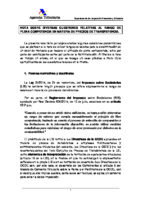
Spain releases note on arm’s length range and benchmarking.
On 25 February 2021, a note was released by the Spanish Tax Agency on number of practical issues relating to application of the arm’s-length range. The note – which is based on the OECD transfer Pricing Guidelines, guidance on benchmark studies issued by the Joint Transfer Pricing Forum, and relevant Spanish case laws – answers the following questions – How is the range of values determined? – Is it possible to determine a range of values in which the figures are relatively equally reliable? – How to proceed if a range is determined in which all figures are not relatively equally reliable? – When should statistical tools be used to narrow the range? – What should be done if there is a wide dispersion in the range? – Where in the range should the value of the linked transactions be selected? – When can the administration adjust the values used by the taxpayer in its controlled transactions covered by a range of values? The note concludes that – Any transfer pricing adjustment requires justification that the value declared by the taxpayer does not comply with the arm’s length principle. – While in some cases it will be possible to determine a single figure as a more reliable benchmark to establish whether a transaction is at arm’s length, in many cases the application of the most appropriate valuation method will lead to a range of figures. – In determining a range of arm’s length values, those transactions with a lower degree of comparability should be eliminated. Also, to the extent that comparability can be improved and where possible, comparability adjustments should be made for those values that require them. However, it is common for a lack of information to prevent such adjustments from being made. – A range of values with a wide dispersion is often indicative of comparability defects in the values that determine the range and should lead to a more detailed analysis. – After such refinements, a range of values could be obtained in which all results are very reliable and relatively equal. In this case, any point in the range complies with the arm’s length principle and therefore no adjustment is appropriate if the value reported by the taxpayer is within the range. If it is outside the range, the adjustment will take the value of the controlled transaction to the value that is closest within the range. – In practice, the range will usually not comprise very reliable and relatively equal results. In this case, once the least comparable results have been eliminated, if there are still defects in comparability that cannot be identified or quantified (and therefore cannot be adjusted for), statistical tools are commonly used which, while not eliminating these defects in comparability, improve the reliability of the analysis. This is achieved by narrowing the range by using only those values between the 1st and 3rd quartiles. – In this case, if the value declared by the taxpayer is within the arm’s length range (whether declared by the taxpayer and accepted by the government or determined by the government), no adjustments should be made. – If, on the other hand, the value declared by the taxpayer is outside the range, the adjustment should generally be made to the median. This is unless, as expressly stated in EU doctrine, after a thorough analysis of the facts and circumstances of the case, there is justification for choosing another particular point in the range, with the burden of proof falling on the person seeking to assert that other point. Click here for English translation
Paraguay’s TP Decree in effect as of April 2021
Paraguay’s new Transfer Pricing Decree in effect as of April 2021. Click here for English Translation

Australia finalises compliance guideline on intangibles migration arrangements – PCG 2024/1
17 January 2024 the Australian Taxation Office published the final version of its Practical Compliance Guideline PCG 2024/1 Intangibles migration arrangements. The PCG has previously been released in drafts as PCG 2021/D4 and PCG 2023/D2 Intangibles arrangements. The final version sets out ATO’s compliance approach to the tax risks associated with certain cross-border related party intangibles arrangements involving: restructures or changes to arrangements involving intangible assets (referred to as ‘migrations’ in the PCG) the mischaracterisation or non-recognition of Australian activities connected with intangible assets. Changes and additions included in the final version: further clarification of the arrangements in scope exclusion of certain arrangements (‘Excluded Intangibles Arrangement’) from the scope inclusion of a ‘white zone’ for arrangements that have been subject to previous ATO audit or reviews further explaining our compliance approach, including the engagement taxpayers can expect based on the compliance risks associated with an arrangement expanding the guidance allowing taxpayers to group intangible assets or arrangements to make it easier for taxpayers apply the PCG providing more information on the reporting requirements taxpayers can expect to complete the reportable tax position schedule.

2023: ATO Draft Practical Compliance Guidelines on Intangibles Arrangements, PCG 2023/D2
The Australian Taxation Office (ATO) has released a new draft of Compliance Guidelines on Intangible Arrangements, PCG 2023/D2. When finalised, the guidelines will set out the ATO’s compliance approach to the development, use and transfer of intangible assets. The guidelines focus on tax risks associated with the potential application of the transfer pricing provisions, withholding tax provisions, capital gains tax (CGT), capital allowances, the general anti-avoidance rule (GAAR) and the diverted profits tax (DPT). Examples of high-risk intangibles arrangements under the draft guidelines include centralisation of intangible assets bifurcation (separation) of intangible assets non-recognition of local intangible assets and DEMPE activities migration of pre-commercialised intangible assets (HTVI) transfer of intangibles assets to a foreign hybrid entity

2021: ATO Draft Practical Compliance Guidelines on Intangibles Arrangements, PCG 2021/D4
The Australian Taxation Office (ATO) has issued draft Compliance Guidelines on intangible arrangements, PCG 2021/D4. These Guidelines will (when finalised) set out the ATO’s compliance approach to international arrangements connected with the development, enhancement, maintenance, protection and exploitation of intangible assets, specifically, the potential application of the transfer pricing, general anti-avoidance rule (GAAR) and the diverted profits tax (DPT) provisions. The capital gains tax and capital allowances provisions will also be discussed in this Guideline where these may be considered alongside, or relevant to, the ATO’s transfer pricing, GAAR or DPT risk assessment. The draft Guidelines sets out ATO’s compliance approach to international arrangements connected with the development, enhancement, maintenance, protection and exploitation (DEMPE) of intangible assets and/or involving a migration of intangible assets. The Guidelines applies to Intangibles Arrangements and focuses on tax risks associated with the potential application of the transfer pricing provisions. It also focuses on other tax risks that may be associated with Intangibles Arrangements, specifically the withholding tax provisions, capital gains tax (CGT), capital allowances, the general anti-avoidance rule (GAAR) and the diverted profits tax (DPT). The Guidelines has been prepared to accompany the release and publication of Taxpayer Alerts TA 2018/2 Mischaracterisation of activities or payments in connection with intangible assets and TA 2020/1 Non-arm’s length arrangements and schemes connected with the development, enhancement, maintenance, protection and exploitation of intangible assets. It is not the intention of the Guidelines to limit, deter or prevent arm’s length dealings involving intangible assets. Rather it is intended that the Guideline will serve as a point of reference and assist in understanding arrangements which is seen as representing a higher risk from a compliance perspective. Examples of high risk arrangements centralisation of intangible assets bifurcation (separation) of intangible assets non-recognition of local intangible assets and DEMPE activities migration of pre-commercialised intangible assets non-arm’s length licence arrangements

German TP-Legislation updated as of June 2021
German legislation on transfer pricing has been updated to align the rules with the OECD Transfer Pricing Guidelines 2017. The new amendments are effective as of fiscal year 2022. The rules includes revised content on Substance over form Risk analysis Best method rule Use of interquartile range Aggregation of transactions Determination of actual ownership vs legal ownership DEMPE functions Valuation of Hard to value intangibles Unofficial translation of the new amendments to the German TP legislation Article 5 Amendment of the Foreign Tax Act The Foreign Tax Act of 8 September 1972 (BGBl. I p. 1713), as last amended by Article 4 of the Act of 25 March 2019 (BGBl. I p. 357), shall be amended as follows: section 1 shall be amended as follows: (a) Paragraph 1 shall be amended as follows: aa) In sentence 1, the words “related” shall be replaced by the word “related”. bb) In sentence 2, the words “and within the meaning of § 1a” shall be inserted after the word “provision”. (b) Paragraph 3 shall be replaced by the following paragraphs 3 to 3c: “(3) For the determination of the transfer prices (arm’s length prices) corresponding to the arm’s length principle for a business relationship within the meaning of paragraph 1 sentence 1, the actual circumstances underlying the respective business transaction shall be decisive. In particular, it shall be taken into account which functions are performed by which person involved in the business transaction in relation to the respective business transaction, which risks are assumed in this respect and which assets are used for this purpose (function and risk analysis). The relationships within the meaning of sentences 1 and 2 shall form the standard for determining the comparability of the business transaction to be examined with business transactions between unrelated third parties (comparability analysis); the relationships on which these business transactions are based shall be decisive in the corresponding application of sentences 1 and 2, insofar as this is possible. The circumstances at the time of the agreement of the business transaction shall be taken into account. The arm’s length price shall in principle be determined according to the most appropriate transfer pricing method with regard to the comparability analysis and the availability of values for comparable transactions of independent third parties. Differences between the ratios of the arm’s length transactions used for comparison and the ratios underlying the transaction under review that may affect the application of the transfer pricing method shall be eliminated by appropriate adjustments, if possible; this shall only apply if comparability is thereby enhanced. If no comparative values can be determined, a hypothetical arm’s length comparison shall be carried out for the determination of the arm’s length price in compliance with paragraph 1 sentence 3 from the perspective of the supplier and the respective service recipient using economically recognised valuation methods. (3a) The application of the arm’s length principle regularly leads to a range of values. This range shall be narrowed if differences in comparability remain after application of paragraph 3 sentence 6. If these values themselves do not offer any indications for a certain narrowing, the quarter of the smallest and the quarter of the largest values shall be disregarded from this range. If the value used by the taxpayer to determine his income lies outside the range pursuant to sentence 1 or the narrowed range, the median shall be decisive if the taxpayer does not credibly demonstrate that another value complies with the arm’s length principle. When applying the hypothetical arm’s length principle according to paragraph 3, sentence 7, a range of agreement regularly results from the minimum price of the supplier and the maximum price of the service recipient. In the cases of sentence 5, the mean value of the agreement range shall be used as a basis if the taxable person does not credibly demonstrate that another value within the agreement range complies with the arm’s length principle. (3b) If a function, including the associated opportunities and risks as well as the assets or other benefits transferred along with the function, is transferred and paragraph 3 sentence 7 is to be applied to the transferred function because no comparative data can be determined for the transfer of the function as a whole (transfer package), the agreement range shall be determined on the basis of the transfer package. This may be waived if the taxpayer can credibly demonstrate that neither significant intangible assets nor other benefits were the subject of the transfer of function. This applies if the receiving company performs the transferred function exclusively vis-à-vis the transferring company and the consideration to be recognised for the performance of the function and the provision of the corresponding services is to be determined according to the cost-plus method. (3c. A transfer or assignment for use of an intangible asset shall be remunerated if it is made on the basis of a business relationship as defined in paragraph 4 and it has a financial effect on the transferee, the user, the transferor or the assignor. Intangible assets are assets that are neither tangible assets nor equity interests nor financial assets which may be the subject of a transaction without being individually transferable; and which can give a person an actual or legal position over that asset. The identification of the ownership or holder of an intangible asset, including rights derived from such an asset, is the starting point for determining which party to the transaction is entitled to the revenue arising from any disposition of that intangible asset. To the extent that a related party of the owner or holder of the intangible asset performs functions, uses assets or assumes risks in connection with the development or creation, enhancement, maintenance, protection or any form of exploitation of the intangible asset, those functions shall be appropriately compensated by the owner or holder of the related party. The financing of the development or creation, maintenance or protection of an intangible asset shall be appropriately remunerated and shall not give rise
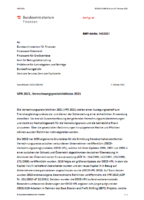
Austrian Ministry of Finance issues Updated Local Transfer Pricing Guidelines (VPR 2021)
In October 2021 the Austrian Ministry of Finance issues updated local transfer pricing guidelines – VPR 2021 The Transfer Pricing Guidelines 2021 (VPR 2021) are an interpretative aid to the arm’s length principle and serve to ensure its uniform application. They are to be regarded as a summary of the applicable transfer pricing provisions and thus as a reference work for administrative and operational practice. Rights and obligations that go beyond the statutory provisions cannot be derived from the guidelines. In 1995, the OECD published general principles for the determination of arm’s length transfer prices between associated enterprises (OECD Transfer Pricing Principles; OECD TPG), which were published with their updates in 1996, 1997 and 1998 in a German translation agreed between Switzerland and Austria in the Official Gazette of the Austrian Tax Administration (AÖF No. 114/1996, 122/1997, 155/1998, 171/2000). In 2010, a major update of the OECD TPG followed, in which Chapters I to III were revised in depth and a new Chapter IX relating to corporate reorganisations was added (OECD TPG 2010). Based on this, Austria’s own guidelines were published for the first time in 2010: the VPR 2010 (AÖF No. 221/2010 idF 22/2011). Since then, the OECD TPG have been continuously developed. Particularly comprehensive changes to the OECD TPG have recently resulted from the OECD/G20 work in the context of the Base Erosion and Profit Shifting (BEPS) project which VPR 2021 GZ 2021-0.586.616 of 07 October 2021 resulted in an update in 2017 (OECD-TPG 2017). Therefore, there is a need for a fundamental revision of the VPR 2010, a repeal of the existing enactments and a new promulgation of the VPR (VPR 2021). Within the scope of this fundamental revision, the previous structure of the VPR was largely retained, but some very comprehensive additions were necessary. In addition, the latest version of the BMF Info on the Transfer Pricing Documentation Act (BMF Info of 17 December 2019, BMF-010221/0395-IV/8/2019) was incorporated into the VPR as section 3.2. For reasons of clarity and transparency, the VPR are therefore newly promulgated. The VPR 2021 replace the Transfer Pricing Guidelines 2010 (VPR 2010). Link to Austrian Local Transfer Pricing Guidelines 2021 Unofficial English Translation

Spain releases report on application of their General Anti-Abuse Rule.
The Spanish tax authorities have published a report on the applicability of their domestic General Anti-Abuse Rule (GAAR). In the report, a conduit arrangement aimed at benefiting from an exemption at source on the payment of interest to EU residents is described. Click here for English translation
Finnish TP-Legislation updated to include non-recognition and recharacterisation
Effective as of 1. January 2022 Finnish Transfer Pricing legislation has been updated to align the rules with the OECD Transfer Pricing Guidelines in regards to non-recognition and recharacterisation. Going forward the arm’s length provision in the Tax Procedure Act, section 31, will include the possibility for non-recognition and recharacterisation which according to Finnish Case Law has not been possible under the previous wording of the provision.

South African Revenue Service releases comprehensive Interpretation Note on intra-group loans
The South African Revenue Service (SARS) has published a comprehensive Interpretation Note on intra-group loans. The note provides taxpayers with guidance on the application of the arm’s length principle in the context of the pricing of intra-group loans. The pricing of intra-group loans includes a consideration of both the amount of debt and the cost of the debt. An intra-group loan would be incorrectly priced if the amount of debt funding, the cost of the debt or both are excessive compared to what is arm’s length. The Note also provides guidance on the consequences for a taxpayer if the amount of debt, the cost of debt or both are not arm’s length. The guidance and examples provided are not an exhaustive consideration of every issue that might arise. Each case will be decided on its own merits taking into account its specific facts and circumstances. The application of the arm’s length principle is inherently of a detailed factual nature and takes into account a wide range of factors particular to the specific taxpayer concerned.

Italy releases operational instructions on arm’s length range and benchmarking.
On 24 May 2022, the Italian Tax Agency (Agenzia delle Entrate) released CIRCULAR NO. 16/E containing operational instructions on issues relating to application of the arm’s length range. The circular – which is based on the OECD transfer Pricing Guidelines, guidance on benchmark studies issued by the Joint Transfer Pricing Forum, and relevant Italian case laws – provides operational instructions regarding the correct interpretation of the notion of “arm’s length range”, as also specified in Article 6 of the Decree of 14 May 2018, when applying the provisions set forth in Article 110, paragraph 7, of the Consolidated Income Tax Act or of the provisions contained in the Double Taxation Treaties entered into by Italy in accordance with Article 9 of the OECD Model Convention. The operational instructions concludes as follows the correct application of the most appropriate transfer pricing method may, instead of a single value, lead to a range of values all complying with the arm’s length principle; in such cases, the full range of values within the arm’s length range may be used if all the transactions identified in the range are equally comparable; if, on the other hand, some of the transactions within the range show defects of comparability that cannot be reliably identified or quantified and, therefore adjusted, the use of ‘statistical tools’ (in order to strengthen their reliability) and a value within the narrow range is preferable. Recourse, on the other hand, to a value as central as possible within the range (also in order to minimise the risk of error due to the presence of such defects) must be limited to cases in which the range does not include values characterised by a sufficient degree of comparability even to consider reliable any point within the narrow range by means of statistical tools and must, in any case, be specifically justified; Therefore, it will be the responsibility of the Offices to resort to the “full range” for the purpose of identifying the arm’s length range only in those cases in which a perfect comparability of all the observations of the set with the “tested party” can be discerned. In conclusion, in recalling once again that according to the OECD Guidelines the identification of a set of values could be symptomatic of the fact that the application of the arm’s length principle allows in certain circumstances to reach only an approximation of the conditions that would have been established between independent enterprises, it is recommended that the adjustments involving the identification of the point that best satisfies the arm’s length principle within the range be argued in detail. Click here for English translation Click here for other translation
The Netherlands releases New 2022 Decree on application of the Arm’s Length Principle
On 1 July 2022, the tax authorities in the Netherlands published Decree No. 2022-0000139020 of 14 June 2022 containing local guidance on application of the arm’s length principle. The Decree is based on article 9 of the OECD Model Tax Convention and the OECD Transfer Pricing Guidelines and also contains references to local case laws. In the Decree, particular focus is on areas that have been updated in the most recent releases of the OECD Transfer Pricing Guidelines – Legal ownership, DEMPE functions, Services, HTVI and Valuation Methods, Government policies (COVID-19), Remuneration of Procurement activities, Financial transactions etc. Click here for Unofficial English translation Click here for other translation
AFIP has published a non exhaustive list of Low and No Tax Jurisdictions (LNTJ)
The Federal Tax Administration of Argentine (AFIP) has published a non exhaustive list of 41 Low and No Tax Jurisdictions (LNTJ). The list related to Law 27,430 from 29 December 2017 which introduced certain adverse tax implications for transactions with LNTJs. For instance, according to the Law transactions with unrelated parties in LNTJs are not deemed arm’s length for transfer pricing purposes. Furthermore such transactions are required to be reported to the tax authorities. LNTJs refers to jurisdictions where the income tax rate is 60% lower than the minimum 25 % CIT rate applicable in Argentina. Hence, LNTJs are jurisdictions that apply an income tax rate lower than 15%. Click here for English Translation
German draft-legislation on application of the arm’s length principle to cross-border relocation of functions
On 5 July 2022, the Federal Ministry of Finance in Germany published draft legislation regarding application of the arm’s length principle to cross-border relocation of functions. According to the general provisions A function is a business activity that consists of a grouping of similar operational tasks performed by specific units or departments of an enterprise. It is an organic part of an enterprise, without the need for a sub-operation in the tax sense. A transfer of functions within the meaning of section 1(3b) of the Foreign Tax Act occurs if a function, including the associated opportunities and risks as well as any assets or other benefits that may have been transferred or left along with it, is transferred or left in whole or in part so that the acquiring company can perform this function or expand an existing function. The function transferred as a whole in accordance with sentence 1 constitutes the transfer package. Business transactions that are realised within five business years shall be combined as a single transfer of function at the time when the requirements of sentence 1 are economically fulfilled by their joint realisation. In cases of transfer of functions, intangible assets are essential within the meaning of section 1(3b) sentence 2 of the Foreign Tax Act if they are necessary for the transferred function and their arm’s length price amounts in total to more than 25 per cent of the sum of the individual prices of all assets and other benefits of the transfer package and this is credible, taking into account the effects of the transfer of function, which are evident from the records within the meaning of section 2 sentence 2. If an acquiring enterprise independently provides the services previously provided exclusively to the transferring enterprise, in whole or in part, to other enterprises at prices which are higher than the remuneration according to the cost-plus method or which are to be set higher in accordance with the arm’s length principle, a remuneration in accordance with 2 shall be charged to the other enterprises at the time of the first provision for assets and other advantages previously provided free of charge by the transferring enterprise for the provision of services; the assets or other benefits in question shall be deemed to be a transfer package, provided that the other requirements for this are met. A transfer of functions within the meaning of paragraph 2 shall not be deemed to have taken place if there is no restriction on the exercise of the function in question at the transferring company within five years of the assumption of the function by the acquiring company, although the other requirements of paragraph 2, sentence 1 are met (duplication of functions). If such a restriction occurs within this period, a transfer of functions shall be deemed to have taken place at the time when the restriction occurs, unless the taxpayer proves that this restriction is not directly related to the duplication of functions. The legislation will apply retrospectively to covered transactions after 31 December 2021. Click here for unofficial English translation Click here for other translation

2022: ATO Taxpayer Alert on Treaty shopping arrangements to obtain reduced withholding tax rates (TA 2022/2)
The ATO is currently reviewing treaty shopping arrangements designed to obtain the benefit of a reduced withholding tax (WHT) rate under a double-tax agreement (DTA) in relation to royalty or dividend payments from Australia. Typically, this benefit is sought via the interposition of one or more related entities between an Australian resident and the ultimate recipient of the royalty or dividend, where the interposed entity is a resident of a treaty partner jurisdiction. The ultimate recipient is generally located in a jurisdiction that either does not have a DTA with Australia or, where it is a treaty partner of Australia, the DTA provides a less favourable treaty benefit. A key purpose of Australia’s treaty network is to eliminate double taxation without creating opportunities for tax avoidance practices, such as treaty shopping arrangements. We are concerned that some taxpayers have entered into, or are considering implementing, arrangements interposing entities in treaty jurisdictions to obtain a more favourable tax outcome under a DTA in the form of reduced WHT rates. These taxpayers may not be entitled to such benefits under our DTAs. Arrangements that pose a potential risk of treaty shopping may display some of the following features and we are likely to make further enquiries where such factors exist: • Structures and restructures involving the interposition of an existing or newly incorporated entity between Australia and the ultimate recipient of royalties or unfranked dividends. • The interposed entity may have significant existing operations and employees and the taxpayer may contend that commercial benefits and/or synergies flow to the Australian operations or the interposed entity. • Royalty or unfranked dividend payments (or potential future royalty or unfranked dividend payments) to the interposed entity are (or would be) subject to WHT at reduced rates under the relevant DTA compared with Australian domestic law or the applicable WHT rate under the DTA between Australia and the country of residence of the ultimate recipient
Hungary – Legislation on use of Interquartile Range and Median
As part of tax legislation recently enacted in Hungary, rules governing the application of statistical tools – arm’s length range and adjustments within the range – will now be governed by law. When determining arm’s length prices based on benchmarks of comparables it will now be mandatory to use the interquartile range. If the price falls outside the arm’s length range, adjustment must be made to the median value – unless the taxpayer can prove that another value within the range is more appropriate. Where the price is within the arm’s length range, taxpayers will no longer be allowed to make year-end adjustments. The above amendments will have effect for FY 2022 and forward. Furthermore, certain information related to controlled transactions will now have to be provided in the corporate tax return. Details in this regard will be contained in a later Ministerial Decree. Click here for unofficial English translation Click here for other translation

Australian Treasury issues Consultation Paper on Multinational Tax Integrity and Tax Transparency
As part of a multinational tax integrity package aimed to address the tax avoidance practices of multinational enterprises (MNEs) and improve transparency through better public reporting of MNEs’ tax information, the Australian Treasury issued a Consultation Paper in August 2022. This paper seeks to consult on the implementation of proposals to: amend Australia’s existing thin capitalisation rules to limit interest deductions for MNEs in line with the Organisation for Economic Cooperation and Development (OECD)’s recommended approach under Action 4 of the Base Erosion and Profit Shifting (BEPS) program (Part 1); introduce a new rule limiting MNEs’ ability to claim tax deductions for payments relating to intangibles and royalties that lead to insufficient tax paid (Part 2); and ensure enhanced tax transparency by MNEs (Part 3), through measures such as public reporting of certain tax information on a country‑by‑country basis; mandatory reporting of material tax risks to shareholders; and requiring tenderers for Australian government contracts to disclose their country of tax domicile. The changes contemplated seek to target activities deliberately designed to minimise tax, while also considering the need to attract and retain foreign capital and investment in Australia, limit potential additional compliance cost considerations for business, and continue to support genuine commercial activity.

Poland – Ordinance No. 1934 on Transfer Pricing-Documentation
Polish Ordinance No. 1934 of August 29 2022 on transfer pricing documentation. The new ordinance sets out the detailed scope of data and information and the content of the statement contained in the corporate income tax transfer pricing documentation together with explanations on how it should be prepared. Click here for unofficial English translation Click here for other translation
Joint Statement on Pillar I and II by France, Germany, Italy, Netherlands and Spain
France, Germany, Italy, Netherlands and Spain have issued a joint statement to reaffirm their commitment to swiftly implement the global minimum effective corporate taxation (Pillar Two). According to the statement the five countries are also fully committed to to complete the work on the better reallocation of taxing rights from huge global multinationals’ profits (Pillar One) with the objective of signing a multilateral convention by mid-2023.
Malta issues Legal Notice 284 of 2022 implementing Transfer Pricing provisions into its Legislation
On 18 November 2022 Malta published Legal Notice 284 of 2022 whereby transfer pricing rules are implemented into its legislation. The new rules will come in to effect 1 January 2024 in relation to transactions/arrangements entered into on or after that date. For arrangements that have been entered into before that date, the rules will only apply to transactions/arrangements that are materially altered on or after that date. The new transfer pricing provisions will apply to cross border transactions/arrangements carried out between associated parties having 50% or more of common direct or indirect control.
IRS publishes new interim Guidance on Review and Acceptance of APA Submissions
In a memorandum issued April 25, 2023, the IRS provides guidance to their employees of the Treaty and Transfer Pricing Operations practice area in the Large Business and International Division with respect to requests from taxpayers for an APA with the IRS. The guidance instructs IRS personnel on how to review and, where appropriate, accept taxpayer APA requests to align the processes for APAs to be consistent with IRS’ strategy and maximize the probability of successful, timely, and comprehensive resolution of transfer pricing issues for both taxpayers and the IRS. Visit IRS’ webpage for more information on the US Advance Pricing and Mutual Agreement Program.

Poland issues Tax clarifications on transfer pricing – No. 5: Resale Price Method
24 March 2023 the Polish Ministry of Finance issued Tax clarifications on transfer pricing No. 5: Resale Price Method The resale price method (RPM) is one of the traditional transaction methods and probably most useful where it is applied to distribution operations.. Application of the RPM for determining the price of a controlled transaction begins with the price at which a product that has been purchased from an associated enterprise is resold to an independent enterprise. This price (the resale price) is then reduced by an appropriate gross margin on this price (the “resale price margin”) representing the amount out of which the reseller would seek to cover its selling and other operating expenses and, in the light of the functions performed (taking into account assets used and risks assumed), make an appropriate profit. What is left after subtracting the gross margin can be regarded, after adjustment for other costs associated with the purchase of the product (e.g. customs duties), as an arm’s length price for the original transfer of property between the associated enterprises. The resale price method is described in: • Chapter II, Part II, Section C, paragraphs 2.27-2.44 of the OECD Guidelines; • Chapter 4.3 of the UN Handbook See the previous Polish clarifications on transfer pricing: No. 1 – Comparability Analyses and Documenation No. 2 – Transfer Pricing Adjustments No. 3 – CUP method No. 4 – TNMM Click here for unofficial English translation
Germany publishes draft legislation to implement the global minimum tax – OECD Pillar II
The German Federal Ministry of Finance issues draft law for the implementation of the EU Directive to ensure a global minimum level of taxation for multinational groups of companies and large domestic groups in the Union The aim of the draft law is to implement key elements of the international agreements on Pillar 2 of the so-called two-pillar solution. The post-taxation provisions contained therein are intended to ensure a global effective minimum taxation, to counteract harmful tax competition and aggressive tax structuring and thus to contribute to the promotion of tax justice and a level playing field. Click here for unofficial English translation
Canada plans to modernize and strengthen the general anti avoidance rule (GAAR)
According to the Canadian Budget 2023 the government will release for consultation draft legislative proposals to amend the general anti avoidance rule (GAAR) which was added to the Canadian Income Tax Act in section 245 back in 1988. If abusive tax avoidance is established, the GAAR applies to deny the tax benefit that was unfairly created. The GAAR has helped to tackle abusive tax avoidance in Canada but it requires modernizing to ensure its continued effectiveness. The following amendments to the GAAR is proposed: introducing a preamble (containing interpretive rules and statements of purpose); changing the avoidance transaction standard (from a “primary purpose” test to a “one of the main purposes” test); introducing an economic substance rule (indicators for lack in economic substance); introducing a penalty (25% of the amount of the tax benefit); and extending the reassessment period in certain circumstances (three-year extension to the normal reassessment period). The revised GAAR is expected to come into force as of 1 January 2024. See the relevant sections of the Canadian Budget 2023 below.
Brazil publishes new updated 2023 transfer pricing legislation – aligned with OECD guidelines
14 June 2023 Brazil issued it’s new updated transfer pricing legislation, which is now aligned with OECD transfer pricing guidelines. Click here for unofficial English translation
Common Errors made in Country-by-Country reports
On 23 May 2024, the OECD issued guidance on common errors made by multinational enterprise (MNE) groups when preparing their country-by-country (CbC) reports. These reports contain valuable information on the global allocation of income, taxes paid, and the location of economic activity among the tax jurisdictions in which an MNE group operates. This information can be used for a high-level transfer pricing risk assessment, the assessment of other BEPS-related risks, and economic and statistical analysis, if appropriate. However, this information can only be used effectively for these purposes if the data in CbC reports is robust and accurate. Tax administrations have encountered a number of errors in the data contained in CbC reports filed to date, and the new guidance describes the most common of these.
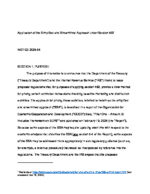
US Notice on application of the Simplified and Streamlined Approach
16 December 2024, the US Treasury Department and the Internal Revenue Service issued a Notice announcing their intention to issue regulations that would provide a new method under the US tranfer pricing rules in Section 482 for pricing certain controlled transactions that involve baseline marketing and distribution activities. The new method, referred to in the US notice 2025-04 as the Simplified and Streamlined Approach (“SSA”), is based on OECD’s Pillar One – Amount B report from February 2024.

Poland issues Tax clarifications on transfer pricing – No. 6: Cost Plus Method
September 29, 2023 the Polish Ministry of Finance has published tax explanations regarding transfer pricing No. 6 regarding the cost-plus method. The purpose of the explanations is to present practical aspects related to the use of the cost plus method. The explanations take into account the recommendations of the Transfer Pricing Forum of September 28, 2021 regarding the description of the cost plus method and comments submitted as part of the tax consultations. The cost-plus method is described in OECD and UN documents: Chapter II, Part II, Section D, paragraphs 2.45-2.61 of the OECD Guidelines; Chapter 4.4 of the UN Handbook See the previous Polish clarifications on transfer pricing: No. 1 – Comparability Analyses and Documenation No. 2 – Transfer Pricing Adjustments No. 3 – CUP method No. 4 – TNMM No. 5 – Resale Price Method Click here for unofficial English translation
FTA Article on Swiss Transfer Pricing Legislation and Practices as of 1 January 2024
The Swiss Federal Tax Authorities have published an Article on the status of transfer pricing legislation in Switzerland as of 1 January 2024. The Article describes the existing legal basis for the application of the arm’s length principle in Switzerland and reference is made to the OECD Transfer Pricing Guidelines as well as to Swiss administrative practice, circulars and case law. The Article highlights the importance of the comparability analysis and focuses on certain aspects of intra-group services, intangibles and financial transactions. With regard to transfer pricing documentation, the Article explains that Switzerland only requires country-by-country reporting. However, it also states that a Swiss taxpayer has a duty to cooperate with the tax authorities, which may involve demonstrating arm’s length pricing of controlled transactions. The official Article is only available in French and German. An unofficial English version of the Article is provided below.
Malta Publishes Local Guidance on Transfer Pricing
On January 19, 2024, the Maltese Commissioner of Taxes and Customs published local guidelines in relation to the transfer pricing rules introduced in Malta in November 2022 by Legal Notice 284 of 2022. The local guidelines refer to the OECD Transfer Pricing Guidelines 2022 in relation to the application of transfer pricing methods, comparability analysis, transfer pricing documentation, etc.
US publishes Memorandum on the Effect of Group Membership on Financial Transactions
On 29 December 2023, the Office of Chief Counsel of the IRS issued a memorandum (AM 2023-008) on the effect of group membership on financial transactions. The memorandum answers the following question: “May the Service consider group membership in determining the arm’s length rate of interest chargeable for intragroup loans and making a section 482 adjustment?” The answer given in the memorandum is “Yes. Under the section 482 regulations, the arm’s length rate of interest on an intragroup loan to a controlled borrower is generally the rate at which that borrower could realistically obtain alternative financing from an unrelated party. Thus, if an unrelated lender would consider group membership in establishing financing terms available to the borrower, and such third-party financing is realistically available, then the Service may adjust the interest rate in a controlled lending transaction to reflect group membership.” The rationale in the memorandum refers to Treas. Reg. §§ 1.482-1, 1.482-2, 1.482-9, OECD TPG 7.13 and 10.76-80 and the realistic alternatives/realistically available options principle.
Brazil publishes comprehensive normative instructions for its new transfer pricing rules
29 September 2023 Brazil published normative instructions (IN RFB nº 2.161/23) for its new transfer pricing rules, which will apply from FY 2024 onwards. Brazil’s transfer pricing legislation is now in line with the OECD Transfer Pricing Guidelines. In fact, the new legislation is the result of a joint project between the Brazilian Federal Revenue Service (Receita Federal do Brasil) and the OECD. The normative instructions deal with the general aspects of the new law, which form the basic part of the new system and apply to all transactions falling within its scope. It addresses practical issues in the application of the new regime and provides simplification measures for some transactions as well as for the fulfilment of ancillary obligations. For companies wishing to apply the new rules for FY 2023, the opt-in deadline has been extended to December. These taxpayers will have to fill in a special form and make their definitive choice between September and December. In December 2022, Provisional Measure 1,152 was issued, significantly modifying Brazilian transfer pricing rules. In June 2023, the Provisional Measure was converted into Law 14.596/23. Click here for unofficial English translation
United Arab Emirates issues comprehensive Transfer Pricing Guide
23 October 2023, the United Arab Emirates issued a comprehensive practical Transfer Pricing Guide. The guide is designed to provide general guidance on the Transfer Pricing regime in the UAE with a view to making the provisions of the Transfer Pricing regulations as understandable as possible to readers. UAE’s Transfer Pricing regulations are contained in Federal Decree-Law No. 47 of 2022 on the Taxation of Corporations and Businesses, Chapter 10.
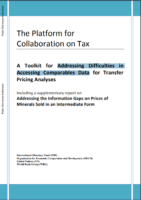
Accessing Comparables Data – A Toolkit on Comparability and Mineral pricing
The Platform for Collaboration on Tax (IMF, OECD, UN and the WBG) has published a toolkit for addressing difficulties in accessing comparables Data for Transfer Pricing Analyses. The Toolkit Includes a supplementary report on addressing the information gaps on prices of Minerals Sold in an intermediate form.
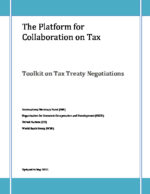
A Toolkit on Tax Treaty Negotiations
The Platform for Collaboration on Tax (IMF, OECD, UN and the WBG) has published a toolkit on Tax Treaty Negotiations. The Toolkit represents a joint effort to provide capacity-building support to developing countries on tax treaty negotiation, building on previous contributions and reducing duplication and inconsistencies. It provides tax officials who have little or no experience in tax treaty negotiation with the tools they need to implement some of the guidance in the UN Manual. It does so by building on Section II of the UN Manual, which sets out how to conduct a tax treaty negotiation in all its phases (preparation, conduct and follow-up), complementing it with a set of tools and resources.
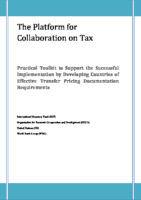
A Toolkit on Implementation of Effective Transfer Pricing Documentation Requirements
The Platform for Collaboration on Tax (IMF, OECD, UN and the WBG) has published a toolkit on implementation of effective transfer pricing documentation requirements.
United Arab Emirates issues comprehensive Transfer Pricing Guide
On 23 October 2023, the United Arab Emirates issued a comprehensive practical Transfer Pricing Guide. The guide is designed to provide general guidance on the Transfer Pricing regime in the UAE with a view to making the provisions of the Transfer Pricing regulations as understandable as possible to readers. UAE’s Transfer Pricing regulations are contained in Federal Decree-Law No. 47 of 2022 on the Taxation of Corporations and Businesses, Chapter 10.
A Toolkit on Confidentiality and Information Security Management (2020)
The Platform for Collaboration on Tax (IMF, OECD, UN and the WBG) has published a Confidentiality and Information Security Management Toolkit (2020) The aim of this Confidentiality and ISM toolkit (the “toolkit”) is to assist countries that wish to participate in the automatic exchange of information (AEOI) by ensuring that they meet good practice standards in confidentiality and data safeguarding. It provides general guidance on implementing legal and information security management (ISM) frameworks that ensure the confidentiality of taxpayer information, including information exchanged under international agreements (“exchanged information”), in line with the requirements of the Standard for Automatic Exchange of Financial Account Information in Tax Matters or “AEOI Standard”. The implementation of good practice ISM frameworks is also relevant to other types of exchange, such as the exchange of information on request, spontaneous exchange of information, and exchange of Country‑by‑Country Reports pursuant to the Base Erosion and Profit Shifting (BEPS) Action 13 standard.
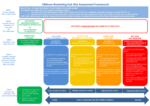
Marketing and Procurement Hubs – Tax Avoidance
The Australian Taxation Office has issued new guidance for multinational groups using offshore marketing- and procurment hubs for tax avoidance purposes. The guidance adresses tax schemes where MNEs uses offshore hubs to shift profits and thereby avoid Australian taxes. Offshore hub arrangements are catagorised by the ATO as white, green, blue, yellow, amber, or red – based on the risk assesment for tax purposes of the transfer pricing setup. The new guidance is a result of recent Australian investigations and hearings into tax avoidance schemes used by Multinational Groups. Tax avoidance in Australia Australian Senate Hearings into Tax Avoidance The overall framework for Australian risk assessment for tax purposes of MNE’s offshore marketing- and procurement hubs is shown below:

US Senate Hearings on Offshore Profit Shifting and Abusive Tax Schemes
See the documents from the US Senate hearings on offshore profit shifting and abusive tax schemes Offshore Profit Shifting and the U.S. Tax Code – Part 1 (Microsoft & Hewlett-Packard) and Part 2 (Apple Inc.), Carl Levin’s opening statements.
